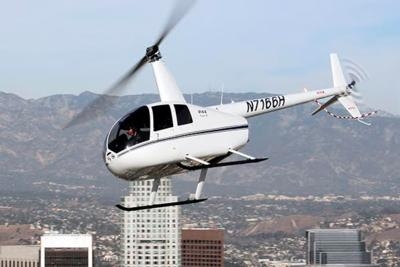Robinson R44 Destroyed By Impact With Terrain
The NTSB has released its probable cause report from an accident which occurred in May, 2014 that fatally injured the pilot of a Robinson R44 aircraft. The Board said the accident was likely caused by the sudden onset of cardiac arrest.

According to the report, The accident flight was one of several recent practice external-load flights that the pilot had been conducting with a 150-ft long-line and weighted barrel. The helicopter approached the airport from the north and then hovered over the approach end of runway 20R. At the time, two airplanes were in the airport traffic pattern for runway 20R, another was in the airport vicinity, and a fourth was departing from runway 2R toward the hovering helicopter. One witness reported hearing the accident pilot attempt to communicate with the departing northbound airplane, but no response was heard, and the airplane passed close to the helicopter. After the northbound airplane passed by, the helicopter moved to its normal landing area on the east ramp, and the accident pilot responded to another pilot's query as to his intentions by stating that he was landing. Immediately after the pilot's response, the helicopter suddenly pitched up, rolled left, and descended to the ground.
Examination of the helicopter revealed no evidence of preimpact mechanical anomalies with the airframe, systems, or powerplant. Damage to the main rotor and associated ground scars and wreckage distribution were consistent with the rotor system operating at normal rpm during the impact sequence. Damage to the helicopter and the location of the main rotor ground scar were consistent with the helicopter having collided with the ground in an extreme left roll. The long-line remained attached to the barrel but was not attached to the helicopter's cargo hook, and the disconnected end was near the main wreckage. The relative orientation of the long-line and the main wreckage indicated that the line was still attached to the helicopter when the helicopter moved laterally at some point; however, no known witness observed when or how smoothly the line and load were released.
Maneuvering a helicopter to land during external load operations requires precision in both helicopter control and timing of load release. Although the accident pilot's workload was increased by the demands of maintaining traffic separation and communicating on the radio in the busy, nontowered airport environment, there was no evidence to suggest that such an operation was beyond his skill level, particularly given his recent practice. The accident pilot was based at BCV and, in the 2 weeks before the accident, had conducted seven flights (including the accident flight) with a 150-foot long-line in the accident helicopter; in the preceding 90 days, the pilot had flown almost 60 hours, most of which involved autorotations, hover maneuvers, and long-line practice.
The pilot's autopsy identified severe coronary artery disease with greater than 75% stenosis in two main arteries. In addition, scarring in the left ventricle was identified, which indicated that the pilot had experienced a previous heart attack. Although the pilot had sought and received in recent years medical care that included cardiac testing, there is no evidence that his previous heart attack was ever diagnosed (research has shown that the tests are not always accurate), and he was not taking any preventive medication. Given the presence of two severely stenotic lesions in two main arteries, the presence of scarring from a previous heart attack, and the absence of medication to prevent a recurrent cardiac event, the accident pilot's likelihood for experiencing another acute cardiac event was inevitable. An acute cardiac event would likely leave no identifiable evidence on autopsy and cause symptoms ranging in severity from impairing (such as chest pain and shortness of breath or palpitations) to
incapacitating (fainting from low blood pressure or sudden cardiac death). Considering the precision required while maneuvering to land with an external load, any level of impairment could result in catastrophic consequences; therefore, the pilot likely experienced a sudden, acute cardiac event that adversely affected his performance.
The NTSB determined the probable cause of this accident to be the pilot's loss of control of the helicopter due to impairment or incapacitation from a sudden, acute cardiac event.
(Image from file. Not accident aircraft)
 ANN FAQ: Contributing To Aero-TV
ANN FAQ: Contributing To Aero-TV Aero-News: Quote of the Day (12.10.25)
Aero-News: Quote of the Day (12.10.25) ANN's Daily Aero-Term (12.10.25): North Atlantic High Level Airspace (NAT HLA)
ANN's Daily Aero-Term (12.10.25): North Atlantic High Level Airspace (NAT HLA) Airborne 12.08.25: Samaritans Purse Hijack, FAA Med Relief, China Rocket Fail
Airborne 12.08.25: Samaritans Purse Hijack, FAA Med Relief, China Rocket Fail Airborne-Flight Training 12.04.25: Ldg Fee Danger, Av Mental Health, PC-7 MKX
Airborne-Flight Training 12.04.25: Ldg Fee Danger, Av Mental Health, PC-7 MKX



